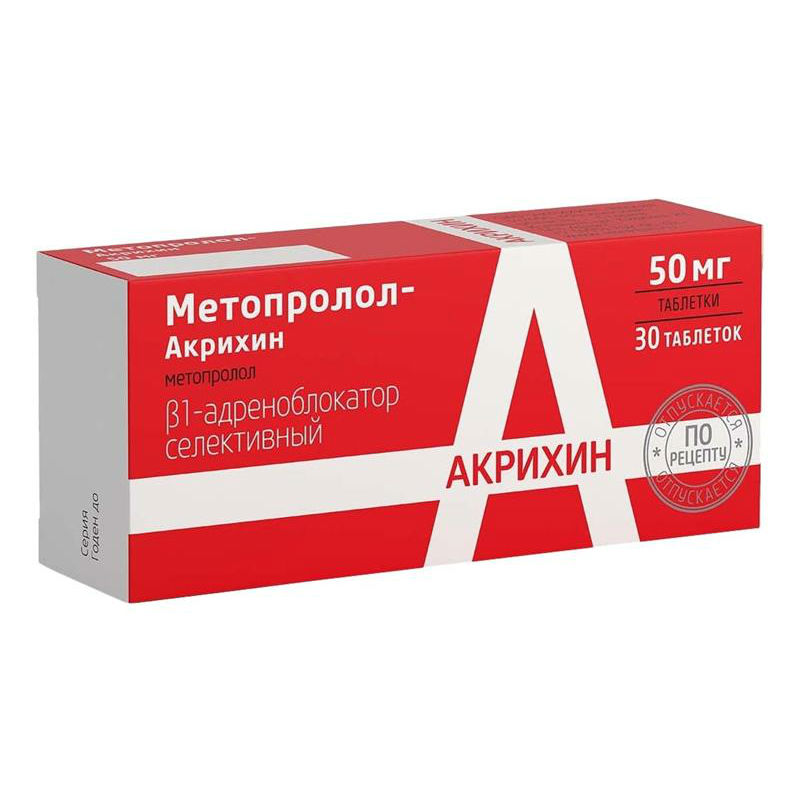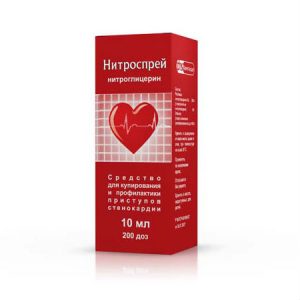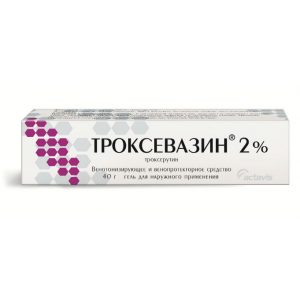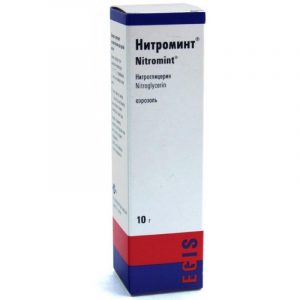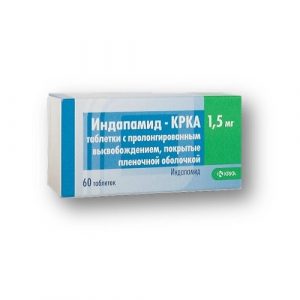Description
Latin name
Metoprolol
Release form
Tablets.
Packaging
In a blister pack of 10 tablets. There are 3 blisters in the package.
Indications
arterial hypertension, arterial hypertension of the I and II degree (monotherapy is possible, in severe cases – in combination with diuretics and other antihypertensive drugs)
angina pectoris, prevention of angina attacks
cardiac arrhythmias, supraventricular paroxysm extrasystole)
acute myocardial infarction and secondary prevention after myocardial infarction
hyperkinetic cardiac syndrome, essential cardiovascular hyperkinesis, functional cardiac abnormalities, accompanied by palpitations
idiopathic dilated cardiomyopathy -vascular system and coronary disease (including sudden death)
prophylaxis Stand
migraine thyrotoxicosis (complex therapy)
treatment of akathisia caused by antipsychotic drugs.
Contraindications
atrioventricular block II and III degree
sinoauricular block
sinus bradycardia (heart rate less than 60 per minute)
sinus weakness syndrome
arterial hypotension s. stages uncompensated heart failure
acute heart failure
cardiogenic shock (metoprolol should not be prescribed to patients with suspected acute myocardial infarction)
metabolic acidosis
predisposition to bronchospasm spermatic hyperplasia hyperplasia hyperplasia concomitant use with MAO
inhibitors individual intolerance (including a history of hypersensitivity) prolola.
Restrictions on use:
Allergic history, bronchial asthma, emphysema, non-allergic bronchitis, hyperthyroidism, psoriasis, pheochromocytoma, impaired liver and / or kidney function, myasthenia gravis, depression, general anesthesia, pregnancy, breastfeeding, elderly and childhood.
Use during pregnancy and lactation
Metoprolol is contraindicated in pregnancy, lactation, and children.
Composition
1 tablet contains:
Active substances:
metoprolol tartrate 50 mg.
Excipients:
silicon dioxide colloidal anhydrous,
microcrystalline cellulose,
sodium carboxymethyl starch (type A),
magnesium stearate.
Shell composition:
hypromellose,
polysorbate 80,
talc,
titanium dioxide (E171).
Dosage and administration
Inside, with food or immediately after eating, without chewing and drinking with liquid.
Arterial Hypertension: the initial daily dose is 50-100 mg in 1-2 doses (morning and evening). With insufficient therapeutic effect, the daily dose can be gradually increased to 100-200 mg and / or other antihypertensive agents are additionally prescribed.
The maximum daily dose is 200 mg.
Angina pectoris, arrhythmias, prevention of migraine attacks: 100-200 mg per day in two divided doses (morning and evening).
Secondary prevention of myocardial infarction: 200 mg per day in two divided doses (morning and evening).
Functional disturbances in cardiac activity accompanied by tachycardia: 100 mg per day in two divided doses (morning and evening).
In elderly patients, with impaired renal function, as well as with the need for hemodialysis, the dose is not changed.
In case of impaired liver function, the dose should be reduced depending on the clinical condition.
Side effects of the
From the nervous system: increased fatigue, weakness, headache, slowing of the speed of mental and motor reactions rarely – paresthesia in the limbs (in patients with intermittent claudication and Raynaud’s syndrome), depression, anxiety, decreased attention, drowsiness, insomnia , nightmares, confusion or short-term memory impairment, muscle weakness.
On the part of the sensory organs: rarely – decreased vision, decreased secretion of lacrimal fluid, dry and sore eyes, conjunctivitis, tinnitus.
From the cardiovascular system: sinus bradycardia, palpitations, decreased blood pressure, orthostatic hypotension, dizziness, sometimes loss of consciousness) rarely – reduced myocardial contractility, temporary worsening of symptoms of chronic heart failure (edema, swelling of the feet and / or lower legs, shortness of breath), arrhythmias, manifestation of angiospasm (increased peripheral circulation disorders, cooling of the lower extremities, Raynaud’s syndrome), impaired myocardial conduction, cardialgia.
From the digestive system: nausea, vomiting, abdominal pain, dry mouth, diarrhea, constipation, impaired liver function, taste change.
From the skin: urticaria, pruritus, rash, exacerbation of psoriasis, psoriasis-like skin reactions, hyperemia of the skin, exanthema, photodermatosis, increased sweating, reversible alopecia.
From the respiratory system: nasal congestion, difficulty breathing out (bronchospasm when prescribed in high doses – loss of selectivity and / or in predisposed patients), shortness of breath.
From the endocrine system: hypoglycemia (in patients receiving insulin), rarely: hyperglycemia (in patients with diabetes mellitus), hypothyroidism.
Laboratory indicators: rarely – thrombocytopenia (unusual bleeding and hemorrhage), agranulocytosis, leukopenia, increased activity of liver enzymes is extremely rare – hyperbilirubinemia.
Influence on the fetus: intrauterine growth retardation, hypoglycemia, and bradycardia are possible.
Other: pain in the back or joints, like all beta-blockers, in rare cases can cause a slight increase in body weight, decreased libido and / or potency.
Drug Interaction
Concomitant use with monoamine oxidase (MAO) inhibitors is not recommended due to a significant increase in antihypertensive activity. The interval between treatment with MAO inhibitors and metoprolol should be at least 14 days.
Simultaneous administration of verapamil may provoke cardiac arrest. Concomitant administration of nifedipine leads to a significant decrease in blood pressure.
Inhalation anesthesia (hydrocarbon derivatives) increases the risk of myocardial function suppression and the development of hypotension.
Beta-blockers, theophylline, cocaine, estrogens (sodium retention), indomethacin and other non-steroidal anti-inflammatory drugs (sodium retardation and blocking of prostaglandin synthesis by the kidneys) all attenuate the antihypertensive effect.
There is an increase in the depressant effect on the central nervous system – with ethanol summation of the cardio-depressive effect – with anesthesia drugs, increasing the risk of peripheral circulation disorders – with ergot alkaloids.
When taken together with oral hypoglycemic agents, their effect with insulin may be reduced – increasing the risk of hypoglycemia, increasing its severity and lengthening, masking some symptoms of hypoglycemia (tachycardia, sweating, increasing blood pressure).
When combined with antihypertensives, diuretics, nitroglycerin or blockers of slow calcium channels can develop a sharp decrease in blood pressure (special caution is required when combined with prazosin) increase in the severity of heart rate reduction and inhibition of atrioventricular conduction when using metoprolol with verapamil, diltiaromide, antithromycin, antipyretic general anesthesia and cardiac glycosides.
Inductors of liver microsomal enzymes (rifampicin, barbiturates) lead to increased metoprolol metabolism, decreased plasma metoprolol concentration, and decreased effect.
Inhibitors (cimetidine, oral contraceptives, phenothiazines) – increase blood plasma concentrations.
Allergens used for immunotherapy, or allergen extracts for skin samples when combined with metoprolol increase the risk of systemic allergic reactions or anaphylaxis, iodine-containing X-ray contrast agents for I / O administration increase the risk of anaphylactic reactions.
Reduces the clearance of xanthine (except for dipyllin), especially in patients with initially elevated theophylline clearance under the influence of smoking. Reduces lidocaine clearance, increases plasma concentration of lidocaine. Strengthens and prolongs action of antidepolarizing muscle relaxants prolongs anticoagulant effect of coumarins.
When combined with ethanol, there is an increased risk of a marked decrease in blood pressure.
Overdose
Symptoms:
severe sinus bradycardia, dizziness, vomiting, cyanosis, pronounced blood pressure, arrhythmias, ventricles development of complete transverse blockade and cardiac arrest), cardialgia. The first signs of overdose manifest themselves after 20 minutes – 2 hours after taking the drug.
Treatment:
gastric lavage and appointment of adsorbing agents symptomatic therapy: in case of pronounced decrease in blood pressure – the patient should be in the position of Trendelenburg in case of excessive decrease in blood pressure, bradycardia and heart failure – in / in, with an interval of 2-5 minutes, bath adrenostimulators – up to the desired effect or in / in 0.5-2 mg of atropine sulfate. In the absence of a positive effect – dopamine, dobutamine or norepinephrine (norepinephrine). As a follow-up, perhaps the administration of 1-10 mg of glucagon, the staging of transvenous intracardiac pacemaker. At bronchospasm it is necessary to enter in / in stimulators of beta 1 -adrenoreceptors. In convulsions – slow in / in the introduction of diazepam. Hemodialysis is not effective.
Storage conditions
Store at a temperature not exceeding 30 ° C, in a dry place.
Expiration
5 years.
Deystvuyuschee substances
Metoprolol
pharmacy terms and conditions
prescription
Formulation
Dosage form
tablets
